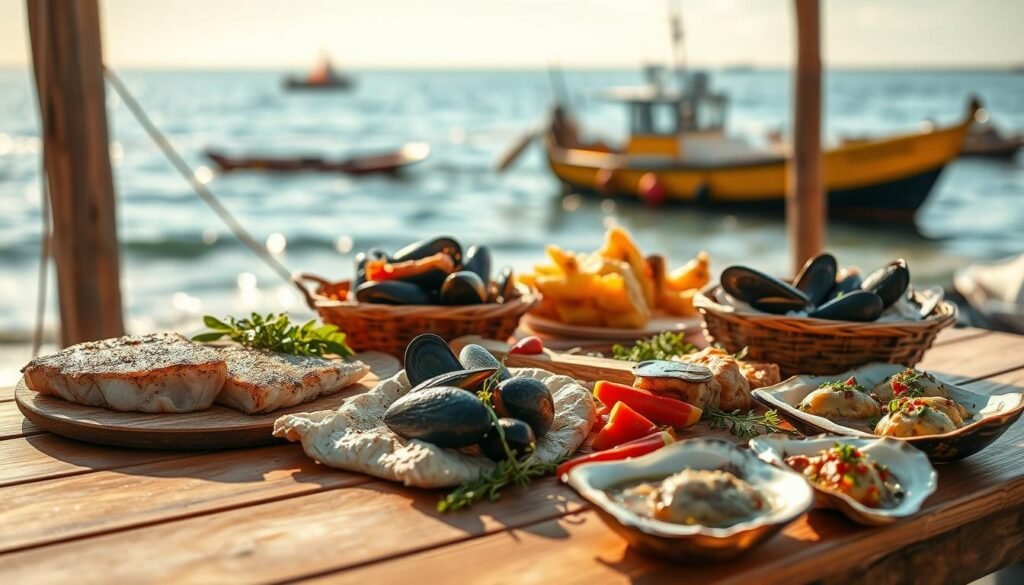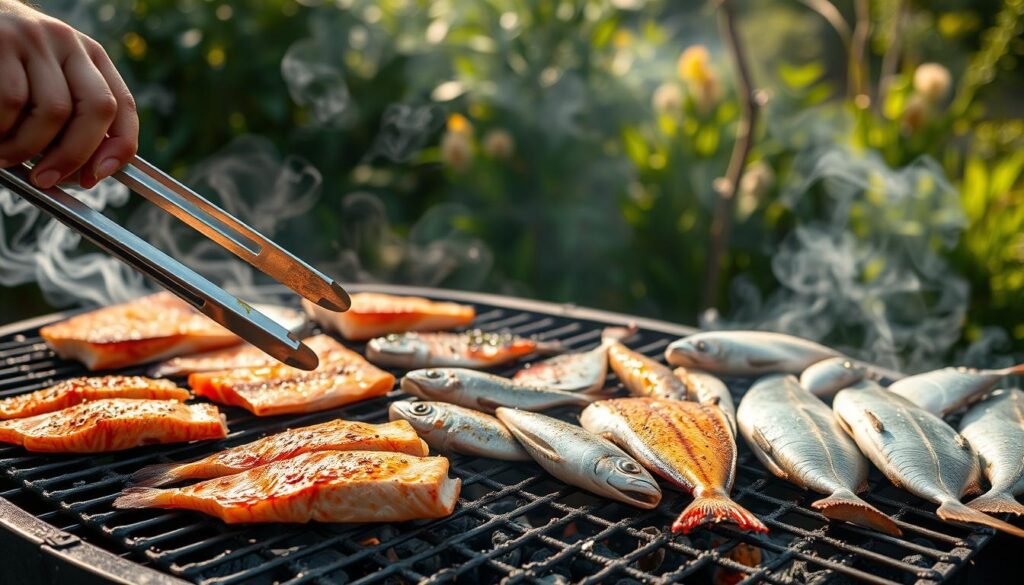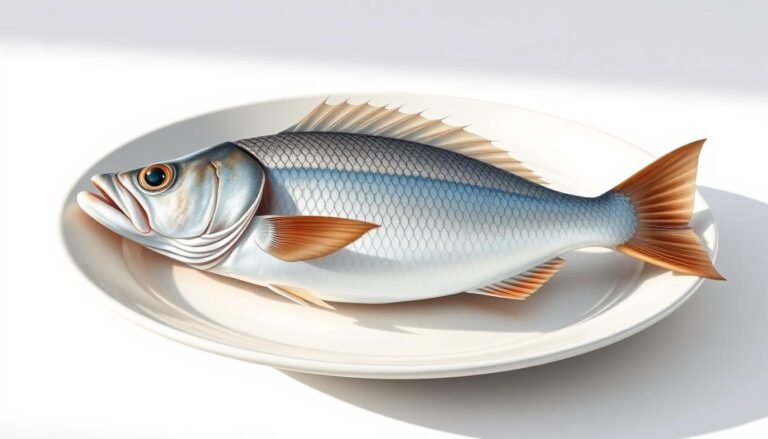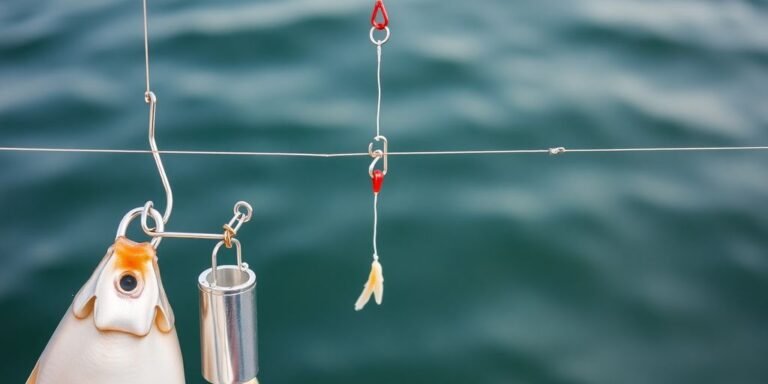Sustainable seafood is not only nutritious but also incredibly versatile. It can be prepared in numerous ways, offering endless flavor possibilities.
The various cooking techniques allow you to enjoy fish in different ways, from broiling and poaching to grilling and baking. Understanding how to cook fish can elevate your dining experience.
Key Takeaways
- Discover the versatility of sustainable seafood
- Learn various cooking techniques for fish
- Explore healthy fish recipes techniques
- Understand the benefits of different cooking methods
- Enhance your dining experience with perfectly cooked fish
Why Cooking Method Matters for Different Fish
Different fish types require specific cooking methods to bring out their best flavor and texture. The characteristics of the fish, such as its texture, fat content, and natural flavor, play a significant role in determining the most suitable cooking technique.
Understanding Fish Texture and Fat Content
The texture and fat content of fish are crucial factors in choosing a cooking method. Lean fish, like cod and sole, have less fat and are more prone to drying out, making them better suited for moist-heat cooking methods such as steaming or poaching. On the other hand, fatty fish like salmon and tuna can withstand higher heat and are often grilled or pan-fried.
| Fish Type | Fat Content | Suitable Cooking Methods |
|---|---|---|
| Lean Fish (Cod, Sole) | Low | Steaming, Poaching |
| Fatty Fish (Salmon, Tuna) | High | Grilling, Pan-frying |
How Cooking Methods Affect Flavour and Nutrition
The cooking method not only affects the flavor of the fish but also its nutritional value. Methods like steaming and poaching help retain the nutrients in fish, while high-heat methods like grilling can lead to a loss of some nutrients. However, grilling can also enhance the flavor by caramelizing the natural sugars in the fish.
Understanding the impact of different cooking methods on fish is essential for preparing delicious and nutritious meals. By choosing the right cooking technique based on the type of fish, you can ensure that your seafood dishes are both flavorful and healthy.
Choosing Sustainable Australian Seafood
Australia is renowned for its diverse seafood, but choosing sustainable options is key to preserving marine ecosystems. Sustainable seafood is not only nutritious, being an excellent source of lean protein, but it’s also incredibly versatile, offering endless ways to cook it and a wide range of potential flavors.
Popular Sustainable Fish Species in Australia
Some of the most popular sustainable fish species in Australia include:
- Australian Salmon: Abundant and fast-growing, making it a sustainable choice.
- Blue Grenadier: A deep-sea fish that’s not only delicious but also caught using sustainable fishing methods.
- Barramundi: Often farmed sustainably, Barramundi is a favorite among seafood lovers.
Seasonal Considerations for Fresh Fish
Understanding the seasonality of fish is crucial for making sustainable choices. Certain fish are at their best during specific times of the year, and choosing these options supports sustainable fishing practices. For instance, Bluefin Tuna is typically in season during the summer months, while Mud Crab is more abundant in the warmer months.

The Best Fish Cooking Methods for Perfect Results Every Time
Mastering various fish cooking methods is essential for any home cook or professional chef. Different cooking techniques can significantly impact the flavor, texture, and nutritional value of fish. Understanding these methods allows you to choose the best approach for the type of fish you’re preparing.
Overview of Traditional and Modern Techniques
Traditional fish cooking methods include grilling, baking, steaming, and pan-frying. These techniques have been used for centuries and are still popular today due to their simplicity and effectiveness. Modern techniques, on the other hand, incorporate new technologies and innovative approaches, such as sous vide cooking and air frying, to achieve precise results and unique textures.
Grilling and baking are excellent for fatty fish like salmon, as they help retain moisture and flavor. Steaming is ideal for delicate fish, preserving its tender texture and subtle flavors. For those looking for a crispy exterior, pan-frying is a great option, especially when combined with a flavorful batter or coating.
Matching Methods to Australian Fish Varieties
Australia offers a diverse range of fish varieties, each suited to different cooking methods. For instance, Barramundi is well-suited for grilling or pan-frying due to its firm texture. Snapper and Flathead are excellent when baked or steamed, as these methods help preserve their delicate flavors.
Understanding the characteristics of different fish varieties and matching them with the appropriate cooking techniques is key to achieving perfect results every time. Whether you’re cooking a fatty fish like mackerel or a lean fish like ling, selecting the right cooking method will enhance the dining experience.
Grilling Fish: Mastering the Barbie
Mastering the art of grilling fish can elevate your outdoor cooking experience, providing a delicious and nutritious meal. Grilling fish is a popular summer activity in Australia, offering a healthy alternative to traditional barbecue fare.
Direct vs. Indirect Grilling Techniques
When it comes to grilling fish, the technique used can significantly impact the final result. Direct grilling involves placing the fish directly over the heat source, ideal for thinner fillets or smaller whole fish. This method achieves a nice char on the outside while cooking the fish through. On the other hand, indirect grilling involves cooking the fish away from the direct heat, suitable for larger or thicker pieces that require more cooking time without burning the exterior.

Best Australian Fish for Grilling
Australia offers a diverse range of fish suitable for grilling. Some of the best options include:
- Barramundi
- Snapper
- Mackerel
- Swordfish
| Fish Type | Thickness | Grilling Method |
|---|---|---|
| Barramundi | Medium | Direct |
| Snapper | Thin | Direct |
| Mackerel | Medium | Direct |
Step-by-Step Grilling Guide for Perfect Results
To achieve perfect results when grilling fish, follow these steps:
- Preheat the grill to medium-high heat.
- Season the fish with salt, pepper, and your choice of herbs.
- Brush the grill with oil to prevent sticking.
- Place the fish on the grill, skin side down if it has skin.
- Cook for 4-6 minutes per side, or until cooked through.
By mastering these grilling techniques and choosing the right Australian fish, you can enjoy a delicious and healthy meal that’s perfect for any summer gathering.
Baking Fish: Foolproof Oven Techniques
To achieve perfectly cooked fish, baking is a foolproof technique worth mastering. Baking fish in the oven is a healthy way to prepare a meal without adding extra fat, retaining the vital goodness of the fish, such as omega-3 fatty acids and other nutrients.
Dry Baking vs. En Papillote
Baking fish can be done in two primary ways: dry baking and en papillote (or parcel baking). Dry baking involves seasoning the fish and baking it directly on a tray, while en papillote involves sealing the fish in a parcel, usually with aromatics, to steam cook it in its own juices.
For a simple and flavorful dish, try dry baking with a marinade. As suggested by Kylee’s Cooks, oven-baked fish can be incredibly easy and delicious.
Temperature and Timing Guidelines
The key to perfectly baked fish lies in the temperature and timing. Different fish varieties require different temperatures and cooking times. Here’s a general guideline:
| Fish Type | Oven Temperature (°C) | Cooking Time (minutes) |
|---|---|---|
| Salmon | 200 | 12-15 |
| Barramundi | 180 | 10-12 |
| Snapper | 220 | 8-10 |
Flavour Enhancers and Marinades
To enhance the flavor of baked fish, various marinades and seasonings can be used. Lemon juice, herbs, and spices are popular choices. For en papillote, adding aromatics like garlic and thyme can infuse the fish with delightful flavors.
“The art of cooking is not just about following a recipe, it’s about understanding the ingredients and techniques to create something truly special.” – Anonymous
Experimenting with different flavor combinations can elevate your baked fish dishes, making them a staple in your culinary repertoire.
Steaming: The Healthiest Way to Cook Seafood
Steaming is recognized as one of the healthiest ways to prepare seafood, preserving its natural flavors and nutrients. This cooking method involves using steam to heat the food, which helps retain the delicate texture and flavor of seafood.
Traditional Steaming vs. Modern Appliance Methods
Traditional steaming involves placing seafood in a steamer basket over boiling water, covered with a lid. This method allows for a gentle cooking process that doesn’t require added oils, making it a low-calorie cooking option. Modern appliance methods, such as using electric steamers or instant pots, offer convenience and precise control over cooking time and temperature.
- Electric steamers provide a set-it-and-forget-it approach, ideal for busy cooks.
- Instant pots combine steaming with pressure cooking, reducing cooking time significantly.
Asian-Inspired Steamed Fish Preparations Popular in Australia
Asian cuisine offers a variety of steamed fish preparations that have gained popularity in Australia. These dishes often incorporate flavors like ginger, soy sauce, and sesame oil, enhancing the natural taste of the seafood without overpowering it.
Popular Asian-inspired steamed fish dishes include:
- Steamed fish with ginger and scallions, a classic Cantonese dish.
- Thai-style steamed fish in coconut milk with lemongrass and chilies.
Preserving Nutrients and Delicate Flavours
Steaming is an effective way to preserve the nutrients in seafood. Unlike frying, steaming doesn’t involve high temperatures that can destroy delicate vitamins and omega-3 fatty acids. Moreover, steaming helps maintain the seafood’s natural flavors, making it a preferred method for those who enjoy the subtle taste of fresh seafood.
By choosing steaming as your cooking method, you’re not only opting for a healthier meal but also ensuring that the seafood’s inherent qualities shine through.
Pan-Frying and Shallow Frying Fish
Pan-frying fish is a versatile cooking method that yields a crispy exterior while keeping the interior moist. This technique is ideal for those who enjoy a crunchy texture on their fish without deep-frying. It’s a quick and flavorful way to prepare fish, making it perfect for weeknight dinners.
Achieving the Perfect Crispy Skin
To achieve a crispy skin, it’s essential to start with dry fish. Pat the fish dry with paper towels before seasoning. Use a hot pan with a small amount of oil, and don’t overcrowd it. Cook the fish skin-side down first, allowing it to crisp up before flipping. This technique helps in creating a crunchy texture that complements the tender flesh.
Oil Selection and Temperature Control
The choice of oil for pan-frying is crucial. Opt for oils with a high smoke point, such as avocado oil or grapeseed oil, to prevent the oil from burning at high temperatures. Maintaining the right temperature is also key; too low, and the fish absorbs excess oil; too high, and the outside burns before the inside is cooked. Aim for a medium-high heat to achieve a golden crust.
Quick Weeknight Fish Dinner Ideas
Pan-frying fish is a great option for a quick weeknight dinner. Try pairing pan-fried fish with a simple salad or roasted vegetables for a balanced meal. For a more flavorful dish, marinate the fish in a mixture of lemon juice, garlic, and herbs before cooking. Serve with a side of quinoa or couscous for a nutritious and satisfying meal.
Some popular fish for pan-frying include Barramundi, Snapper, and Flathead. These varieties hold up well to the high heat and yield a deliciously crispy exterior. Experiment with different seasonings and marinades to find your favorite flavor combinations.
Deep Frying and Beer Battering: Aussie Fish and Chips
For many Australians, the taste of perfectly deep-fried fish coated in a crispy beer batter is a culinary delight. This beloved dish, known as fish and chips, is a staple in Australian cuisine. The technique of deep frying and beer battering is crucial in creating the perfect fish and chips.
Perfect Batter and Coating Recipes
Creating the perfect batter is an art. A good beer batter should be light, crispy, and full of flavor. To achieve this, you can use a mixture of flour, cornstarch, and a raising agent, along with a cold beer. Some popular recipes also include additional ingredients like spices or herbs to enhance the flavor.
- Use cold beer for a lighter batter
- Add spices or herbs for extra flavor
- Don’t overmix the batter
Safety Tips for Deep Frying
Deep frying can be hazardous if not done properly. It’s essential to follow safety guidelines to avoid accidents. Always use a deep fryer with a thermometer to monitor the oil temperature, and never leave the fryer unattended.
Key safety tips:
- Monitor oil temperature
- Never leave the fryer unattended
- Use a deep fryer with a lid
Healthier Alternatives to Traditional Deep Frying
While traditional deep frying is delicious, it’s not the healthiest option. For a healthier alternative, you can try baking or air frying your fish and chips. These methods significantly reduce the oil content without compromising on taste.
By experimenting with different cooking techniques and ingredients, you can enjoy your favorite Aussie fish and chips while making it a bit healthier.
Alternative Cooking Methods: Poaching, Sous Vide and Raw Preparations
Beyond grilling and baking, alternative cooking techniques such as poaching, sous vide, and raw preparations provide unique flavors and textures. These methods offer fish enthusiasts a range of options to explore beyond traditional cooking techniques.
Gentle Poaching Techniques for Delicate Fish
Poaching is an excellent method for cooking delicate fish without losing moisture or flavor. To poach fish, bring a liquid (such as water or broth) to a simmer, then reduce the heat to a low temperature. Gently add the fish to the liquid, ensuring it’s fully submerged. Cook for 8-10 minutes or until the fish flakes easily. Using a gentle poaching technique helps preserve the fish’s natural texture and flavor.
Sous Vide Fish for Restaurant-Quality Results
Sous vide cooking involves sealing the fish in a bag and cooking it in a water bath at a precise temperature. This method allows for perfectly cooked fish every time, as it eliminates the risk of overcooking. To cook fish sous vide, season the fish, seal it in a bag with any desired aromatics, and cook in a preheated water bath at 120°F – 130°F (49°C – 54°C) for 1-2 hours.
Safe Raw Preparations: Ceviche, Sashimi and Tartare
Raw fish preparations, such as ceviche, sashimi, and tartare, are popular for their fresh flavors and textures. When preparing raw fish, it’s crucial to use extremely fresh, sashimi-grade fish to minimize the risk of foodborne illness. For ceviche, marinate the raw fish in citrus juices for 15-30 minutes to ‘cook’ it. For sashimi and tartare, serve the raw fish immediately, ensuring it’s handled and stored safely.
Conclusion: Elevating Your Fish Cooking Skills
Mastering various fish cooking techniques is key to elevating your seafood preparation skills. As discussed, different methods such as grilling, baking, steaming, and frying can be used to achieve perfect results every time. The best fish cooking method depends on personal preferences, the type of fish, its size, and the time available.
By understanding the characteristics of different fish and applying the appropriate cooking technique, you can enhance the flavour and nutritional value of your seafood. Whether you’re preparing a quick weeknight dinner or a special occasion meal, the right cooking method can make all the difference.
Experimenting with various cooking techniques and recipes will help you develop your fish cooking skills, allowing you to confidently prepare a wide range of delicious seafood dishes. With practice, you’ll be able to choose the most suitable method for your favourite fish, ensuring a consistently enjoyable dining experience.





